The Pineapple Building: A Unique Architectural Gem in Dubai
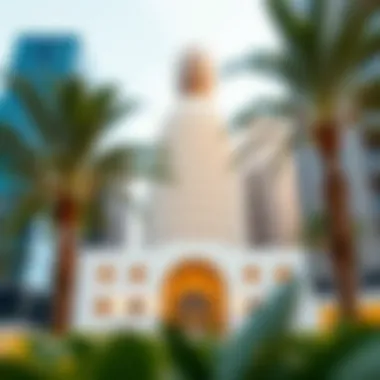
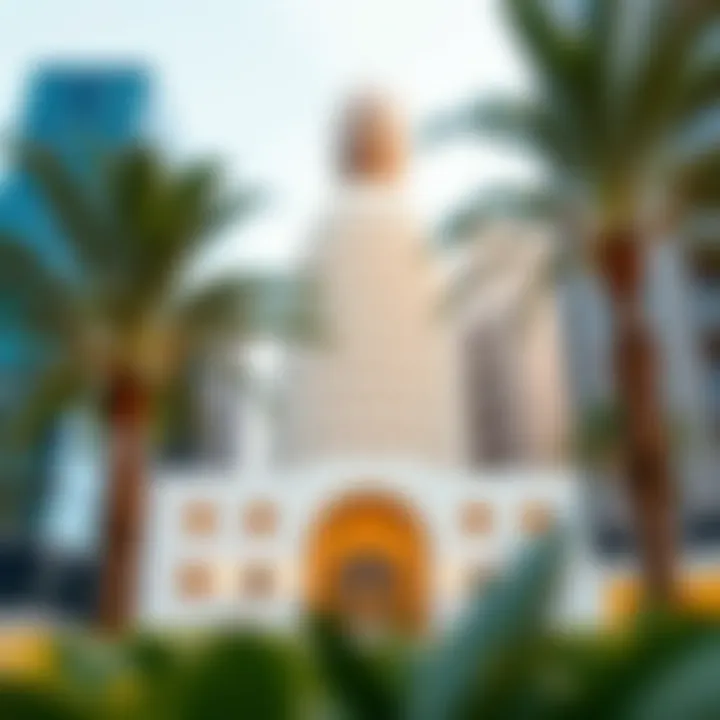
Intro
In the heart of Dubai, where modernity meets tradition, lies a structure that is quickly becoming a landmark of architectural innovation—the Pineapple Building. This remarkable edifice not only redefines the city's skyline but also embodies the ambitious spirit of a metropolis always striving for the extraordinary. Characterized by its distinctive fruit-inspired design, this building represents more than just a place of residence or commerce. It stands as a testament to the integration of sustainability and advanced engineering practices in contemporary architecture.
As the landscape of real estate continues to evolve rapidly, investors and homebuyers are increasingly drawn to projects that offer unique visual experiences and functionality. With the Pineapple Building, developers have successfully created a space that merges aesthetic appeal with practical environmental considerations, thereby signaling a shift in how buildings can contribute to their urban surroundings.
Throughout this article, we will explore the multifaceted aspects of the Pineapple Building, analyzing its design elements, cultural impact, and the role it plays within Dubai's ever-shifting real estate market. The narrative will also provide insights into what makes this architectural marvel appealing to investors and real estate enthusiasts alike.
Here, we aim not just to showcase the building itself but to place it within a broader context that highlights its relevance in an increasingly competitive market.
Market Insights
The dynamic nature of Dubai's real estate market is influenced by various factors including economic trends, population growth, and tourism rates. Understanding these trends is essential for potential investors and homebuyers looking to navigate this complex landscape effectively.
Current Trends in Dubai Real Estate
Dubai's real estate sector is characterized by rapid expansion and innovation. The demand for unique designs, like the Pineapple Building, reflects a broader trend towards personalization and individualistic architecture. Consider the following patterns:
- Luxury Living: More buyers are seeking luxury properties that offer amenities beyond basic expectations. Buildings that incorporate unique designs are becoming highly sought after.
- Sustainability Focus: As environmental awareness rises, developers are prioritizing sustainable practices. The Pineapple Building's eco-friendly features are a prime example of this shift.
- Investment Opportunities: With annual tourism attracting millions, investors are recognizing the potential for lucrative returns in residential and commercial spaces.
Price Fluctuations and Forecasts
The price landscape in Dubai's real estate market has shown volatility influenced by various external and internal dynamics. Recent years have seen fluctuations in both residential and commercial property prices, which can be attributed to:
- Regulatory Changes: Updates in rental laws and property ownership rules can impact market prices.
- Global Economic Conditions: Shifts in the global economy, including exchange rates and trade policies, often ripple down into local markets, altering property valuations.
- Supply and Demand: Increasing supply, especially from high-profile projects like the Pineapple Building, can initially lead to lower prices but ultimately impacts desirability in the long run.
For potential buyers, grasping these price trends is crucial. Seeking expert guidance can help in making informed decisions and ensuring valuable investments in Dubai's housing market.
Preamble to the Pineapple Building
The Pineapple Building stands as a testament to innovation in architecture, contrasting sharply with traditional forms and forging new pathways for Dubai's skyline. In an ever-evolving urban landscape, this unique structure not only inspires awe but also embodies the spirit of creativity that characterizes Dubai. Architects and urban planners have continuously pushed boundaries in a city known for its extravagant designs and bold ambitions.
To understand the Pineapple Building's significance, we must consider how it encapsulates the essence of modern architecture while addressing sustainability and cultural relevance. This structure serves more than just an aesthetic purpose; it is a symbol of what is possible when creativity meets practicality. Investors seeking opportunities within Dubai's property market need to recognize this importance, not just from a design perspective but also in terms of financial viability. The Pineapple Building's design takes inspiration from a beloved tropical fruit, mirroring the region's climate and cultural context.
By strategically positioning itself at the intersection of form and function, this marvel captures the imagination of homebuyers, expatriates, and investors alike. It's imperative to emphasize that the Pineapple Building integrates living spaces while inviting both residents and visitors to engage with its unique environment. This section will delve into an overview of its architectural concept, highlighting how the Pineapple symbolizes freshness, hospitality, and innovation, ultimately making it a landmark structure in Dubai.
Overview of the Pineapple Concept
The concept behind the Pineapple Building can appear whimsical at first glance, yet it carries substantial depth. The design draws directly from the fruit that represents warmth and hospitality, reminiscent of the region's cultural approach to welcoming newcomers and tourists. The building, standing tall amidst the vast desert landscape, reflects not just its eye-catching design but also practicality through its functional spaces.
Key characteristics of this concept include:
- Organic Forms: The Pineapple’s shape embraces curves and textures that break away from rigid structures prevalent in conventional architecture.
- Sustainability Values: Reflecting both nature and modern needs, the design incorporates energy-efficient systems and materials. This aligns with global trends towards eco-friendly buildings, making it attractive to environmentally minded investors.
- Cultural Resonance: Beyond its visual appeal, the Pineapple serves as a cultural landmark, fostering community interaction while celebrating the region's heritage.
The Pineapple Building has the potential to drive conversations around innovative architecture and sustainable living, making it a noteworthy case study for real estate developers and urban planners alike.
Historical Context of Innovative Architecture in Dubai
The significance of exploring the historical context of innovative architecture in Dubai cannot be overstated. Over the past few decades, this city has transcended its humble beginnings as a fishing village to become a global symbol of architectural audacity and modernity. The Pineapple Building stands as a testament to this transformation, reflecting not only contemporary aesthetics but also the cultural and social parameters that shape urban landscapes today.
Dubai's architectural evolution showcases a relentless pursuit of innovation driven by the desire for international recognition. The city's skyline, marked by an array of towering structures, tells a tale of visionary ideas that blend functionality with art. This context is crucial for understanding the impact and design philosophy behind the Pineapple Building.
Evolution of Dubai’s Architectural Identity
The architectural identity of Dubai has undergone significant changes since its inception. Initially characterized by simple structures utilizing traditional materials, the city saw a drastic shift in the late 20th century. The discovery of oil led to rapid economic growth, and with it came a wave of modernization that fundamentally altered Dubai's urban fabric.
- Global Influences: The influx of international architects and designers brought in diverse styles. Iconic projects like the Burj Khalifa, designed by Adrian Smith, not only broke records in structural height but became symbols of ambition.
- Cultural Integration: Modern architects in Dubai have sought to respect and incorporate local heritage. For example, traditional motifs and designs are often juxtaposed with modern materials and techniques to create a distinct architectural language.
- Technological Advancement: As construction technology advanced, skyscrapers became possible. High-speed elevators, modular construction techniques, and sustainability measures emerged in response to not just aesthetic demands, but environmental challenges as well.
As a result, the architectural landscape today includes striking structures like the Pineapple Building, which illustrates a creative departure from conventional designs. This unique structure signifies the blending of natural forms with urban functionality, reinforcing Dubai's position as an avant-garde city in the realm of architecture.
"The Pineapple Building symbolizes a melding of culture with contemporary design, a hallmark of what Dubai aims to achieve in the global architectural arena."
To conclude, delving into the historical context of architecture in Dubai gives vital insight into the Pineapple Building and its role within this vibrant metropolis. Understanding this evolution allows for a greater appreciation of how contemporary challenges and cultural narratives shape not just buildings but the identities of cities themselves.
Design Features of the Pineapple Building
The design features of the Pineapple Building showcase its unique architectural identity while fulfilling functional needs. This fusion of form and usability takes the building beyond mere aesthetics; it stands as a testament to modern design principles and environmental responsibility. With its innovative approach, the Pineapple Building focuses on structural integrity, materials, and sustainability, all encapsulating the essence of contemporary architecture in Dubai. A closer examination of these features reveals how they contribute to both the building's allure and efficiency.
Structural Composition and Materials
The structural composition of the Pineapple Building reflects cutting-edge engineering philosophies, integrating materials that enhance durability while embracing innovative design. One can see the marriage of steel and glass, which not only gives the building its striking visuals but also ensures it's fortified against the elements.
Important elements include:
- Reinforced Concrete: Provides robust support, ensuring the structure withstands high winds and seismic activities, which are crucial due to Dubai's climate and geographical location.
- Double-Glazed Windows: These windows don’t just look good; they play a vital role in energy conservation. They minimize heat gain, thereby reducing the air conditioning demands.
- Laminated Timber: Used in areas requiring a mix of aesthetic appeal and strength, this material echoes the building’s organic pineapple theme, harking back to a nature-centric design approach.
Efficiency in construction is also highlighted by the building's design, allowing for seamless integration of mechanical systems. The structural choices made here set the Pineapple Building apart, avoiding the pitfalls of traditional designs while articulating a bold, fresh vision.
Sustainability and Environmental Considerations
When it comes to sustainability, the Pineapple Building is not merely checking boxes but is in fact setting standards. The design is firmly rooted in eco-friendly practices that reflect a serious commitment to protecting the environment and reducing carbon footprints.
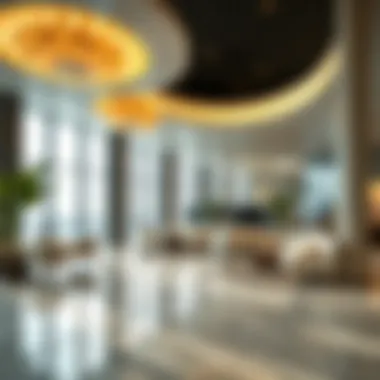
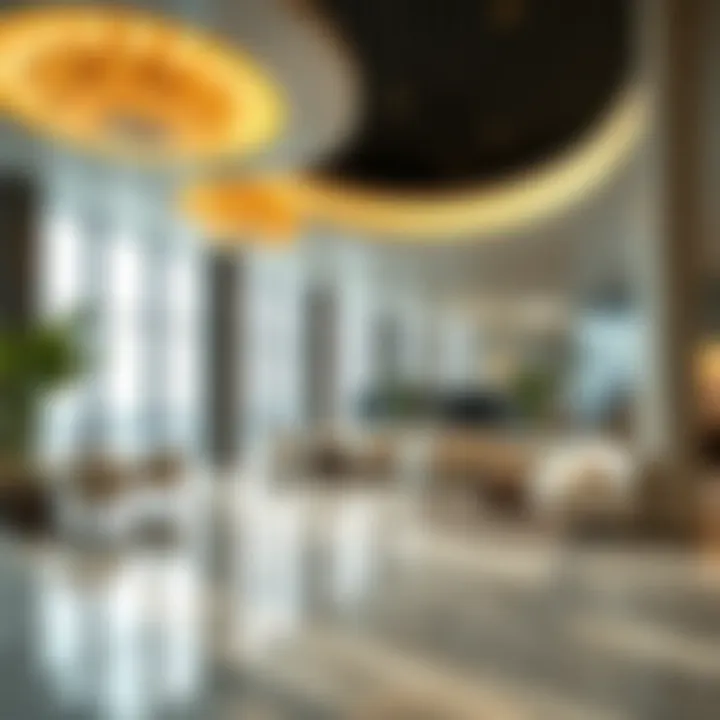
A few notable sustainable features are:
- Green Roof Systems: This feature contributes to biodiversity, allowing plants to thrive and providing insulation for the building, which lowers heating and cooling expenses.
- Rainwater Harvesting Systems: A practical approach that suggests what little can be done to engage with water resources. Capturing rainwater not only aids in irrigation but diminishes the building's dependence on other water sources.
- Solar Panels: Integrated into the facade, they harness Dubai's abundant sunshine. This renewable energy source not only powers the building but contributes significantly to its operational sustainability.
"A remarkable architecture does not only symbolize progress; it embodies responsibility towards our environment and community."
The Pineapple Building doesn’t just aspire to be a landmark; it aims to be a beacon of sustainability in a world increasingly faced with environmental challenges. Integrating such conscientious features ensures it caters not only to the present but also to the future. While the design may attract potential investors and residents with its modern aesthetic, it is these environmentally friendly initiatives that solidify its standing as a pioneer in green architecture.
Architectural Significance
The architectural significance of the Pineapple Building in Dubai is profound, offering insights not just into contemporary design but also into cultural expressions and technological advancements. Its design does more than simply draw the eye; it embodies a blend of artistry and engineering, which speaks volumes about Dubai’s ambition to stand at the forefront of global architecture. As we observe the evolution of structures within this bustling metropolis, the Pineapple Building serves as a defining indicator of what modern architecture can accomplish in terms of aesthetics and functionality.
One important element of its significance lies in its ability to blend local heritage with modern design. The vibrant shape of the building recalls traditional motifs found in the region’s natural landscapes, while integrating innovative materials and techniques characteristic of cutting-edge architecture. This synthesis not only fosters a connection to the past but also enhances the aesthetic dialogue between contemporary and historical contexts.
- Cultural Symbolism: The building acts as a symbol of cultural pride, drawing parallels with the characteristics of the pineapple fruit, which may represent hospitality and warmth, two valued aspects of local culture.
- Community Engagement: Moreover, the structure encourages community interaction by providing open spaces that invite social gatherings and communal activities. This aligns with Dubai’s urban planning ethos, which emphasizes the importance of accessibility and public engagement in architectural works.
Benefits of Architectural Significance:
- Cultural Identity: The Pineapple Building enriches Dubai’s skyline with a unique identity that stands out among a sea of glass and steel towers.
- Tourism Attraction: Its distinctive design draws both locals and tourists alike, bolstering the city’s economy by increasing foot traffic in the surrounding neighborhoods.
- Sustainability: Incorporating eco-friendly materials and technologies not only reinforces a commitment to sustainability but also showcases an architect's consideration for the environment in design practices.
"A landmark is not just a building; it resonates with the stories of the people and the landscape."
The architectural significance of the Pineapple Building cannot be understated. In essence, it is a testament to what Dubai represents: a fusion between the traditional and avant-garde, a daring leap into the future of urban architecture while maintaining respect for cultural roots. As the push for innovative designs continues, the Pineapple Building stands as a beacon of what can be achieved when imagination meets practicality.
Location and Urban Integration
The Pineapple Building stands as a striking example of how innovative architecture can maintain harmony with its surroundings. Its strategic location in the heart of Dubai underscores not just aesthetic appeal but also practicality in urban planning. The concept of location and urban integration plays a critical role, as it directly influences everything from accessibility to community engagement.
The building occupies a prime spot that connects various neighborhoods, enhancing its status as a community hub. This provides not only visual grandeur but also functional advantages that benefit residents and visitors alike. Mumbai's rapid urban development has made it essential for structures to fuse seamlessly into the existing urban fabric rather than merely populate it.
Surrounding Neighborhoods and Accessibility
The Pineapple Building is flanked by a variety of neighborhoods that offer distinct cultural and social environments. For instance, the proximity to the artsy Al Quoz district brings a creative flair, while the bustling Downtown Dubai provides a more commercial vibe. This diversity in surroundings caters to different demographics, making it attractive to both investors and locals.
Moreover, its accessibility is a significant factor in its success. Major transit lines such as the Dubai Metro and several bus routes run near the Pineapple Building. Not only does this ensure ease of movement for residents, but it also enhances the site’s appeal to businesses looking to attract foot traffic and customers.
"Location is paramount to real estate success. The easier it is for people to reach a building, the more valuable it becomes."
The building's design also incentivizes pedestrian access, promoting an active street life around it. This is essential in a city that sees a mix of residents and tourists, leading to a vibrant community atmosphere that can benefit local businesses. The very streets leading to and from the Pineapple Building have been designed to facilitate pedestrian flow, ensuring that access isn't just ease of traveling by car but also walking.
As the city of Dubai continues growing, neighborhoods surrounding the Pineapple Building are likely to see enhanced infrastructure and community services, increasing its value even further. Urban integration here is not just about blending in; it’s about creating synergy that enhances the overall experience of living and working in the area.
In summary, the Pineapple Building's location is not merely a passive characteristic. It strategically positions itself within a web of accessibility and liveliness, which bolsters its functional purpose while heightening its architectural significance. The interwoven relationships between various surrounding neighborhoods reveal an intricate story of urban development that's taken place in Dubai, one that keeps evolving.
Functionality and Usage
Understanding the functionality and usage of the Pineapple Building is central to grasping its role in Dubai's architectural landscape. The structure serves as a pivotal element that defines not only the city’s skyline but also the way individuals interact with their environment. The architects didn’t just have a pretty design in mind; they wanted a building that could contribute significantly to both residential needs and commercial activities, all under one unique pineapple-shaped roof.
Residential vs. Commercial Spaces
In recent years, there has been a peak interest in mixed-use developments that offer a variety of living and working spaces in close proximity. The Pineapple Building stands as a prime example of this trend, accommodating both residential units and commercial offices. This dual purpose is key for fostering community interaction.
- Residential Living: The residential aspect provides modern apartments offering breathtaking views of the city. It has amenities that appeal to families and individuals alike. With close access to parks, retail shops, and recreational areas, these units are designed with convenience in mind. Additionally, sustainability features such as energy-efficient appliances and smart home technology enhance the appeal for environmentally conscious residents.
- Commercial Space: On the flip side, the commercial space targets businesses of varying scales, from startups to established firms. The building's design includes flexible office layouts that can be tailored to meet diverse business needs. The large windows not only let in ample natural light but also create a vibrant working environment. Furthermore, having businesses located within the same complex allows for seamless interactions between residents and working professionals, generating a lively atmosphere.
Both aspects of functionality converge to create a unique lifestyle experience. Residents can live, work, and play within the same locale, which mitigates the need for long commutes and fosters a sense of community. This melding of residential and commercial uses has been carefully thought out to cater to modern urban living requirements, allowing the building to thrive in an ever-changing market.
In essence, the Pineapple Building exemplifies a thoughtful and strategic approach to urban architecture, one that is in tune with the fluctuations of city life. As you consider investment opportunities, both residential and commercial spaces here present viable options that reflect current trends in city planning and real estate development.
"The Pineapple Building is not just about aesthetics; it bridges the gap between living and working, encapsulating the essence of community in urban design."
This multifaceted functionality makes the Pineapple Building an attractive choice for buyers and renters alike. With the allure of modern living combined with business accessibility, it stands poised to play a pivotal role in shaping the future of urban development in Dubai.
Economic Impact of the Pineapple Building
The Pineapple Building stands as a striking new addition to Dubai's ever-expanding skyline, and it represents far more than a unique architectural endeavor. It is vital to explore the economic ramifications of such an iconic structure, as it can significantly affect local markets, employment opportunities, and overall investment perceptions in Dubai. The interplay of these economic factors not only reshapes the immediate area but also sends echoes through the broader real estate landscape of the city.
One notable economic impact stems from the real estate market response triggered by the Pineapple Building's ambitious design and conceptual appeal. As new and more unique buildings arise, they often uplift surrounding property values and bolster interest from investors and buyers alike. The Pineapple Building is no exception; its distinctiveness attracts significant attention, making its surrounding neighborhoods desirable places to live or work.
- Increased Property Values: The proximity to the Pineapple Building is likely to result in a hike in property prices in its vicinity. As potential buyers and investors visualize a vibrant living environment enhanced by the building's architectural charm, they may be willing to pay premium prices, positively impacting local real estate.
- Inflow of Investments: This building can serve as a magnet for foreign investments as well. As international attention shifts towards Dubai’s progressive architecture, it sets the stage for further financial backing in both commercial and residential developments nearby. This could mean not just large-scale housing projects but also new retail spaces, restaurants, and lifestyle amenities that cater to an increasingly discerning clientele.
Real Estate Market Response
The direct response of the real estate market to the Pineapple Building is evident in various forms. Local real estate agents have reported a surge in inquiries for properties post-announcement and development of the building. Many buyers seek not just a residence, but also a lifestyle that aligns with the bustling and innovative energy the Pineapple Building embodies.
- Increased Rental Demand: The demand for rental properties close to the Pineapple Building is on the rise, as young professionals and expatriates find the building's allure and accessibility attractive. This heightened interest often leads to increased rental prices, which translates into direct economic benefit for landlords.
- Diverse Development Projects: Developers may pivot their plans based on the perceived success of the Pineapple Building. If successful, this masterpiece could create a ripple effect encouraging the emergence of additional inspired structures, diversifying the architectural offerings in the region.
"The Pineapple Building is far more than an architectural statement; it’s a catalyst for economic growth and revitalization in the heart of Dubai."
Ultimately, the Pineapple Building is poised to be a cornerstone in shaping Dubai’s real estate market. Not only does it embody innovative design, but its economic implications solidify its role as a pivotal player in transforming the city’s landscape into a beacon of modernity and growth.
Tourism and Cultural Influence
Tourism plays a vital role in the economic and cultural landscape of Dubai. The Pineapple Building, with its striking design and innovative features, serves as a focal point for drawing in visitors from all corners of the globe. This architectural marvel cultivates not just a sense of curiosity but also provides opportunities for immersive experiences that intertwine modernity with local culture.
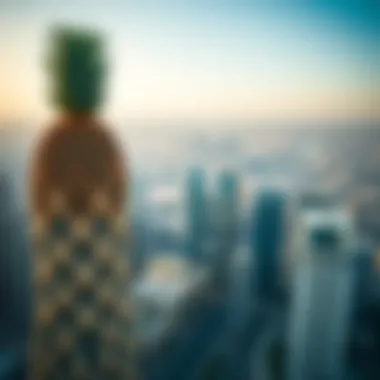
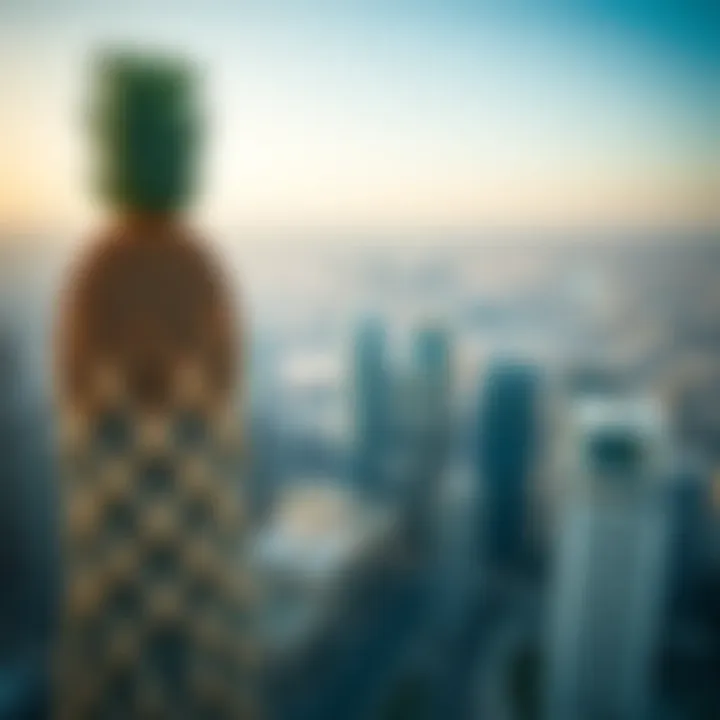
The growing trend of cultural tourism reflects a shift in what travelers seek – it’s not merely about visiting landmarks; it’s about experiencing the essence of a place. The Pineapple Building encapsulates this by merging its contemporary aesthetic with cultural narratives that resonate with both locals and tourists alike. Its unique design symbolizes hospitality, a significant aspect of Emirati culture, making it an appealing landmark to explore.
Specific Elements of Cultural Influence
- Local Symbolism: The pineapple resonates with ideas of warmth and hospitality, deeply rooted in the Emirati tradition. This connection not only fuels tourism but also promotes cultural education.
- Art Exhibitions and Installations: The building could host rotating art exhibits, allowing local artists to showcase their talents while educating visitors about the Emirates' rich heritage.
- Culinary Experiences: A restaurant or café featured within the building can highlight local cuisine, giving visitors a taste of Dubai’s culinary landscape.
Benefits of Enhanced Tourism
- Economic Contributions: Increased foot traffic leads to improved revenues for local businesses, from hotels to shops, providing jobs and bolstering the economy.
- Cultural Exchange: Tourists contribute to a richer cultural milieu, sharing stories and traditions that can foster understanding and appreciation across cultures.
- Promoting Sustainability: With heightened awareness, businesses can showcase sustainable practices that resonate with environmentally-conscious travelers, reinforcing Dubai’s commitment to sustainability.
Considerations for Future Developments
- Infrastructure Improvements: Further attention is needed for transport links to better accommodate the influx of visitors.
- Engagement Strategies: Developing interactive platforms, such as guided tours or AR experiences, can further enhance visitor engagement.
The Pineapple Building is not just an architectural feat; it signifies Dubai's ambition to blend modernity with tradition, a way of inviting the world to experience its cultural heartbeat.
Attraction for Visitors
The allure of the Pineapple Building extends beyond its structure. It beckons with promises of curiosity and exploration.
- Visual Appeal: Its vibrant exterior and unique shape make it an Instagram-worthy destination, attracting social media influencers and casual tourists alike.
- Cultural Programs: Year-round events, such as festivals or cultural workshops, draw diverse audiences, eager to learn and participate in local customs.
- Networking Hub: For international visitors, the Pineapple Building can serve as a networking space, where business meets leisure, ultimately positioning Dubai as a leading global player.
In essence, the Pineapple Building symbolizes a melting pot of ideas, experiences, and cultures, ensuring it’s more than just a stop on the tourist map but a destination in its own right. For investors and businesses, understanding its cultural impact and tourism potential can provide valuable insights into the ever-evolving market within Dubai.
Future Developments Related to the Pineapple Building
As Dubai continues to evolve at a staggering pace, the Pineapple Building sits at the heart of this transformation. The significance of focusing on future developments related to the Pineapple Building cannot be understated. With the surrounding areas undergoing rapid changes, the potential for growth and investment is immense.
The Pineapple Building serves as a catalyst for several prospective projects. It highlights a trend that sees attractive and innovative designs attracting both attention and resources—investors are naturally drawn to areas that offer dynamic and striking landmarks. This building not only adds to the skyline but can also enhance property values in nearby neighborhoods.
Prospective Projects in the Surrounding Area
Several projects are being discussed or initiated in the immediate vicinity of the Pineapple Building. These developmental projects contemplate mixed-use spaces, luxury residential units, and innovative commercial establishments. Here are some noteworthy prospects:
- Cultural Expositions: Plans for cultural centers that would complement the Pineapple Building’s unique architecture, providing spaces for art exhibitions, performances, and workshops.
- Green Spaces: Development of parks and gardens that create a more appealing environment for residents and visitors, linking them to the Pineapple’s sustainable vision.
- Transport Hubs: Improved transport infrastructure focusing on accessibility and connectivity, making it easier for both locals and tourists to enjoy the attractions in the area.
- Luxury Hotels and Resorts: High-end accommodations are being considered, drawing visitors who want to experience the architectural charm and luxury associated with the Pineapple Building.
- Eco-Friendly Commercial Projects: Initiatives that aim to include eco-conscious designs in new retail and office spaces, aligning with global trends towards sustainable construction practices.
"Real estate development in proximity to landmark structures like the Pineapple Building often sees an increase in foot traffic, leading to both commercial and residential interest."
Challenges Faced During Construction
The journey of transforming an ambitious vision into brick and mortar is rarely a smooth one. The construction of the Pineapple Building was no exception to this rule, facing numerous challenges that tested the mettle of everyone involved. Each hurdle, whether logistical or technical, not only impacted the schedule and budget but also shaped the final form of this architectural marvel.
Logistical and Technical Hurdles
Constructing a structure as distinct as the Pineapple Building demands not just creativity but also an intricate choreography of logistics.
- Site Location and Access: Nestled in the bustling heart of Dubai, the location posed significant challenges. Getting materials and labor to the site efficiently required careful planning. Traffic management wasn't just a convenience; it was a necessity to maintain momentum in a city known for its rapid pace.
- Material Selection: The vision for the Pineapple Building centered on a unique facade, reminiscent of the fruit itself, which necessitated specialized materials. Finding suppliers who could deliver high-quality components that met the design specifications was no small feat. The need for sustainability further narrowed the options, requiring a delicate balance between aesthetic appeal and environmental responsibility.
- Construction Techniques: The innovative design of the building led to the necessity for advanced construction techniques. Traditional methods weren't sufficient due to the intricacies of the pineapple-like façade. Skilled labor was essential, and recruiting the right professionals locally sometimes resulted in delays. It brought questions about whether the workforce could adapt quickly enough to new methodologies.
- Weather Conditions: Additionally, Dubai’s extreme weather presented its own set of hurdles. The scorching heat often led to work hour adjustments, causing project timelines to elongate. Workers had to pause during peak sun hours, interrupting workflows and complicating the coordination of tasks.
- Regulatory Approvals: Navigating the local regulatory landscape is another hurdle worth noting. The architectural team had to secure approvals for construction while adhering to numerous safety and city planning standards. Each stage of compliance often required inspections that delayed progress, but ensuring that safety standards were met was crucial for long-term success.
The culmination of these logistical and technical difficulties not only put the project's budgets and timelines to the test but also spoke volumes about the project management acumen displayed. Ultimately, these challenges shaped the Pineapple Building into a resilient structure, ready to withstand not only the physical demands of Dubai’s environment but also the expectations of those who will utilize and admire it.
Market Comparisons with Other Iconic Structures
When one thinks about the architectural wonders of the modern world, structures like the Burj Khalifa, the Sydney Opera House, and the Eiffel Tower often come to mind. Each of these buildings stands not only as a testament to human creativity but also as vital landmarks that shape the economic and cultural landscape of their cities. The Pineapple Building positions itself alongside these iconic structures, prompting a thoughtful examination of its cultural weight, design philosophy, and economic implications when compared to its counterparts. Such comparisons are essential as they provide potential investors, homebuyers, and real estate enthusiasts a sense of perspective in an increasingly competitive and globalized market.
"Architecture should speak of its time and place, but yearn for timelessness." This is especially relevant when assessing the Pineapple Building against similar constructions.
Analysis of Similar Constructions
Several constructions throughout the globe share the innovative spirit with the Pineapple Building. Notable examples include:
- The Eden Project in Cornwall, UK: This environmental marvel features tropical biomes, epitomizing sustainability in design much like the Pineapple Building aims to do. Its partially inflatable structure symbolizes a blend of functionality and environmental consciousness.
- The Guggenheim Museum in Bilbao, Spain: Designed by Frank Gehry, this structure uses curves and intricate shapes that redefine architectural norms. Similar to the Pineapple Building, it has transformed its urban context into a thriving cultural hub.
- The Lotus Temple in Delhi, India: This iconic structure’s flower-like shape serves as a sanctuary for reflection and tranquility. The Pineapple Building’s playful yet serious design mirrors this intention while embracing a lighthearted metaphor within its own architecture.
- The CN Tower in Toronto, Canada: Known as one of the tallest freestanding structures, its sleek and modern design signifies progress, much like the Pineapple Building signifies Dubai’s relentless pursuit of innovation.
When contrasting the Pineapple Building with these structures, several factors emerge as critical:
- Cultural Symbolism: Just like the Lotus Temple represents peace, the Pineapple Building symbolizes hospitality and openness, aimed at fostering a sense of community.
- Economic Revitalization: The Guggenheim Museum serves as a case study in transforming local economies; similarly, the Pineapple Building’s presence could stimulate the Dubai market through tourism and residential appeal.
- Environmental Impact: Drawing lessons from the Eden Project, there is a growing necessity for modern structures to address sustainability—a principle that the Pineapple Building strives to integrate within its construction and use.
As prospective buyers and investors to the Pineapple Building consider their options, the comparisons to these famous iconic buildings should not be overlooked. They reveal the overarching trends and enduring attributes that define standout architecture today. Moreover, understanding how the Pineapple Building aligns or diverges from these completed projects strengthens its value proposition in the competitive Dubai real estate market. An investment in this architectural marvel is not merely an acquisition of property; it's a stake in a narrative that intertwines with the stories told by these globally recognized structures.
Civic Reception and Community Response
The Pineapple Building stands not just as an architectural feast but as a mirror reflecting the community’s values and aspirations. Its reception in Dubai is an intricate dance between admiration, skepticism, and discourse. Understanding civic reception and community response offers a window into how such an iconic structure reshapes not only the skyline but also the social fabric of its surroundings.
The building's unique design ignites conversations among residents, urban planners, and the global community alike. This interaction is invaluable. Local sentiments are important for a project of this magnitude, and gauging their reactions can significantly determine the long-term success of the development. A structure like the Pineapple Building is a conversation starter, inviting diverse voices to share opinions about its impact on the neighborhood and the city at large.
A few key elements to consider regarding the civic reception include:
- Enhanced Community Identity: The building contributes significantly to Dubai's architectural narrative, elevating the city’s profile on a global scale. It allows residents to take pride in a landmark they can call their own.
- Public Engagement: Events held at the Pineapple Building, from art shows to community fairs, offer a platform for dialogue and interaction. These gatherings foster a sense of belonging and involvement in the urban space.
- Investment in Public Spaces: With the increase in foot traffic around the building, there's an undeniable boost to local businesses and public amenities in the vicinity. This economic ripple effect is crucial for sustaining a vibrant community atmosphere.
Interestingly, media coverage has played a pivotal role in shaping public perception. Traditional media and social platforms have been rife with discussions, showcasing a plethora of opinions.
Public Opinion and Media Coverage
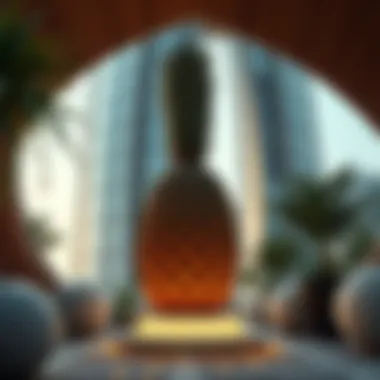
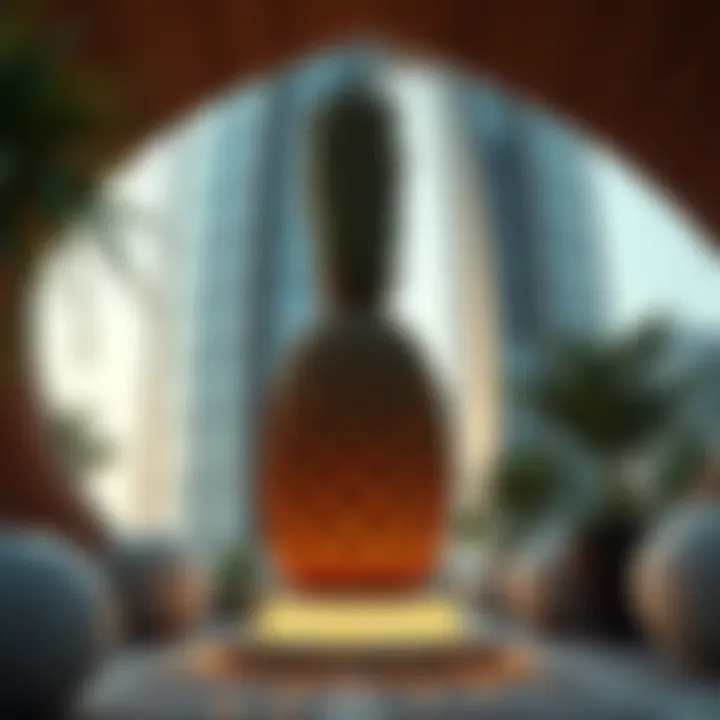
The media has projected varied viewpoints regarding the Pineapple Building, highlighting its architectural splendor while also bringing to light concerns about its implications for the local community. Local news outlets frequently cover urban developments, and the Pineapple Building has been no exception, generating stories that discuss its environmental impacts, societal changes, and aesthetic value.
Public reactions can often be polarized. Some celebrate the innovation and creativity of the design, finding it refreshing in a city overflowing with glass towers and mundane structures. Others raise eyebrows regarding its practicality and the long-term urban plan of the area.
From a grassroots perspective, community members often express their opinions through social media channels, sharing images and personal reflections. Posts frequently include:
- Aesthetic Appreciation: Many showcase the Pineapple Building, highlighting how it adds vibrancy to the city's landscape.
- Concerns about Gentrification: Individuals worry that such landmark projects might push hospitality or commercial growth over the needs of local residents.
"Without dialogue, great structures can become monoliths; they need to be part of the community’s heart to breathe fully."
Ultimately, the civic reception of the Pineapple Building teaches us that architecture isn’t merely about bricks and mortar. It’s about the stories woven into the very fabric of the community it serves. The blend of public opinion and media coverage creates a space for dialogue, ensuring that the conversations sparked by the Pineapple Building continue to evolve as the structure becomes part of Dubai's tapestry.
Architects and Designers Behind the Pineapple Building
The architects and designers behind the Pineapple Building represent a tapestry of innovation and creativity that is pivotal to its identity. The structure is not merely a product of engineering expertise; it’s a compelling expression of artistic imagination aligned with pragmatic considerations that serve both its residents and the broader urban landscape of Dubai. This section delves into who these architects are and what philosophies steer their design choices.
Background and Design Philosophy
The development of the Pineapple Building can be traced back to a few visionary architects, among them the renowned Ahmed Mansoor. His approach is characterized by a commitment to sustainability and a desire to harmonize with the environment. By incorporating local materials and sustainable practices, he aims for a structure that speaks to both modernity and tradition.
A core principle of Mansoor’s philosophy is the integration of cultural motifs within contemporary designs. The Pineapple Building’s curvilinear form echoes the natural shapes found in traditional Emirati architecture while harnessing modern technology. This balance allows it to stand out not just as a structure but as a landmark bridging the past and the future.
"Architecture should not just fill spaces but inspire the people who inhabit them."
The design team also includes landscape architects who placed emphasis on green spaces, which is critical in a bustling city like Dubai. They recognized that amid urban chaos, nature offers a refuge; thus, they designed terraces and gardens that complement the building's aesthetic while also offering residents a touch of tranquility.
Some specific elements that define the architectural approach are:
- Transparency: Large glass facades invite natural light, reducing the reliance on artificial illumination and promoting the well-being of inhabitants.
- Innovative Use of Materials: Utilizing cutting-edge insulation technology helps to regulate interior temperatures efficiently, catering to the often intense Dubai climate.
- Community-Centric Spaces: The design not only caters to individual homeowners or tenants. It focuses on creating communal areas that foster interaction, enhancing the quality of life within the building.
When evaluating the Pineapple Building from an investment perspective, understanding the background of its architects becomes essential. Their originality and dedication to evolving market trends position this property as a prime investment opportunity. For potential homebuyers and real estate enthusiasts, knowing who crafted the building gives an extra layer of assurance regarding its quality and sustainability.
In light of these factors, the Pineapple Building emerges not merely as a habitat, but as a tangible representation of thoughtful design, community, and sustainability that collectively augments Dubai’s architectural narrative.
Impact on Dubai’s Global Image
The Pineapple Building stands as a significant marker of Dubai’s architectural evolution and global image. This structure is more than just a physical entity; it embodies the spirit of innovation and cultural dialogue that resonates throughout the city. As cities vie for recognition on the world stage, unique buildings like this one play an instrumental role in shaping their identities. They become symbols not just of what's possible in architecture, but of what a nation aspires to be.
Enhancing Dubai as a Modern Metropolis
Dubai, often dubbed a modern metropolis, continuously elevates its profile through distinctive structures that draw attention from around the globe. The Pineapple Building contributes to this narrative by showcasing innovative design elements and sustainability initiatives that are in line with cutting-edge global trends. Here are several key factors that make the building a cornerstone of Dubai's contemporary identity:
- Symbol of Progress: The Pineapple Building serves as a reminder that Dubai is not just a city of opulence but also a hub of forward-thinking architecture. Its unique shape and appearance challenge conventional design notions, pushing boundaries that redefine architectural norms.
- Integration of Culture and Modernity: This structure fuses traditional Emirati culture with contemporary aesthetics. It reflects the essence of the UAE's heritage while simultaneously addressing modern needs—an essential balance for cities aiming to maintain cultural integrity amidst rapid growth.
- Attracting Global Investment: With its distinct and eye-catching design, the Pineapple Building attracts attention from both domestic and international investors. It creates an appealing narrative for real estate that emphasizes innovation, which can significantly benefit the city's economy.
- Sustainability as a Global Standard: Incorporating green features in its design, the Pineapple Building raises awareness and sets a precedant for environmental considerations in urban planning. Dubai’s commitment to sustainability is further highlighted, making it more attractive to eco-conscious businesses and investors.
- Cultural Tourism: Unquestionably, a building like this is bound to become a tourist magnet, which is crucial for tourism in Dubai. Visitors are keen to explore architectural feats that reflect the city's ethos, thus increasing foot traffic and benefiting local businesses.
A building’s impact on its environment and society is multifaceted, and the Pineapple Building embodies these various dimensions effectively. Its presence in the Dubai skyline not only adds to the aesthetic appeal but deepens the city’s narrative as a center of contemporary architecture and culture on the global map.
"To be seen as a global player, cities must continually innovate, and the Pineapple Building exemplifies this dynamic, representing both aspiration and achievement."
In summary, the Pineapple Building does more than just enhance Dubai’s skyline; it cements the emirate's status as a forward-looking metropolis that embraces both tradition and modernity, while actively engaging with global challenges.
Investment Opportunities in the Pineapple Building
Investment in the Pineapple Building is not merely a venture into a unique architectural masterpiece; it symbolizes a chance to engage with a rapidly evolving segment of Dubai’s real estate market. With Dubai’s real estate sector continually shifting gears, understanding this building's potential can be a game changer for investors, homebuyers, and developers alike. In a metropolis where traditional high-rises often overshadow innovative designs, the Pineapple Building stands tall as a beacon of modern investment opportunities.
Benefits of Investing
The Pineapple Building offers several significant benefits for investors and stakeholders.
- Cultural Significance: The building's design — reminiscent of a pineapple — reflects Dubai’s embrace of creativity, making it a prime attraction for tourists and locals. This cultural resonance enhances its marketability as a residential or commercial space.
- Sustainability Features: The building’s forward-thinking approach to sustainability adds an edge in attracting eco-conscious tenants and buyers, with energy-efficient systems that promise lower operational costs.
- Prime Location: Nestled within an urban hub, it boasts easy access to major highways and public transportation, rendering it a great choice for commercial ventures and an appealing spot for potential residents.
- Rental Income Potential: Given the increasing demand for rental properties in Dubai, buying into this structure could ensure a steady flow of rental income, particularly when marketed as a unique living or working space.
Considerations for Potential Investors
Investing in an iconic building like this does not come without its set of challenges. Here are a few considerations:
- Market Trends: Potential investors must keep an ear to the ground regarding fluctuations in the Dubai property market, inclusive of rental trends, resale values, and overall economic indicators.
- Maintenance Costs: Like any property, the costs related to maintaining a high-profile architectural structure must be factored into the investment equation.
- Regulatory Framework: Familiarity with local regulations governing properties can prevent future headaches and ensure compliance with Dubai’s stringent building codes.
"Investing isn’t just about numbers; it’s about understanding the story behind a property and its future potential."
As investors evaluate opportunities, it’s essential to adopt a holistic view that encompasses both immediate benefits and long-term growth potential. Understanding the Pineapple Building's place within the broader market framework plays a pivotal role in seizing its investment potential.
Rental and Resale Market Dynamics
The rental and resale market dynamics for the Pineapple Building are a reflection of the broader real estate landscape in Dubai. As urban density increases, the demand for unique living and working environments grows. Here are critical facets:
- Rental Demand: The unique architectural appeal of the building attracts a demographic eager for distinct living spaces. Factors such as proximity to amenities and transport links further elevate its desirability, likely leading to higher rental yields.
- Resale Value: Unique properties often hold a strong resale value due to their architectural significance. Should the Pineapple Building gain acclaim as a landmark, this could positively impact resale prices in years to come.
- Comparative Analysis: Evaluating nearby developments such as Burj Khalifa or the Museum of the Future can provide real insight into potential market positions, helping investors align strategies accordingly.
By keeping a close watch on these fundamental aspects, stakeholders can navigate the potential pitfalls while capitalizing on the myriad opportunities presented by this stunning building.
The End
The conclusion of this exploration of the Pineapple Building serves as a vital juncture for understanding the intricate web of architectural, cultural, and economic impacts it holds within Dubai's landscape. Not merely a structure, the Pineapple Building stands as a beacon of innovation, blending aesthetic appeal with environmental mindfulness. Its design reflects not just what Dubai is today, but also hints at what it aspires to become—a leader in sustainable urban development.
In summarizing this narrative, it is essential to reflect on the following elements:
- Architectural Significance: The Pineapple Building redefines modern architecture by emphasizing creativity and local environmental insights. Its shape and functionality are not haphazard; they are intentional manifestations that speak to both aesthetic pleasure and practical use.
- Cultural Relevance: This building encapsulates Dubai's growing cultural cadence, giving voice to the modern skyline while honoring traditional design elements. It is a cultural touchstone that enriches the narratives surrounding urban development in the region.
- Economic Impact: As the real estate landscape continues to evolve, the Pineapple Building plays an influential role in shaping market dynamics. With growing interest from investors and homebuyers, it sets the stage for lucrative opportunities, thereby enhancing its value.
- Sustainability Focus: The building emphasizes renewable resources and conservation efforts. Its design incorporates features that minimize carbon footprint, promoting a green lifestyle amid urban sprawl.
Considerations surrounding this conclusion urge us to appreciate not only the immediate infrastructure benefits but also the long-term implications of architectural projects like the Pineapple Building. For real estate buyers, developers, and expatriates, it signals a future defined by mindful design, where investment goes hand in hand with sustainable practices, thus encouraging holistic growth in urban environments.
In summation, understanding the Pineapple Building's multifaceted impact offers anyone interested in Dubai's architectural advancements insight into what makes this city a world leader in innovative urban development.















